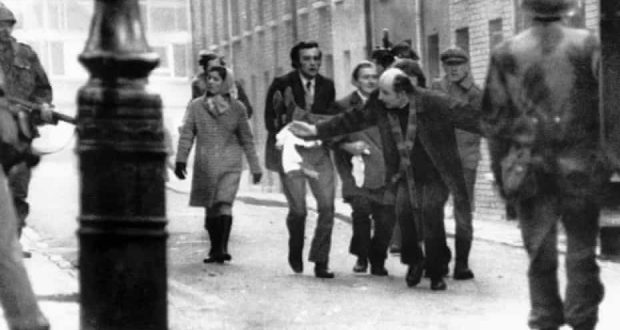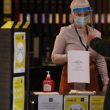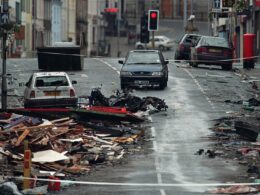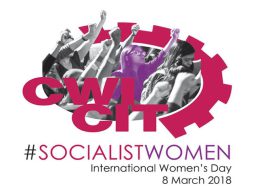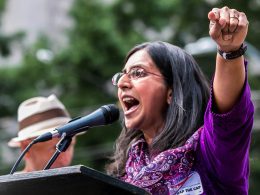By Sean Burns
Sunday, 30 January 1972 saw one of the bloodiest and most callous atrocities committed during the Troubles. In an event that would become known as Bloody Sunday, British paratroopers (paras) fired indiscriminate live rounds into a crowd of unarmed civil rights protesters in Derry. This was state-sanctioned and premeditated murder, resulting in the deaths of 14 innocent people.
The first victim was Jackie Duddy, aged just 17. He was shot as he ran away from soldiers in the car park of Rossville Flats. 13 others were murdered by the paras that day:
- Michael Kelly (17) – shot in the stomach while standing at the rubble barricade on Rossville Street
- Hugh Gilmour (17) – shot as he ran away from soldiers near the barricade
- William Nash (19) – shot in the chest at the barricade
- John Young (17) – shot in the face at the barricade while going to the aid of William Nash
- Michael McDaid (20) – shot in the face at the barricade while going to the aid of William Nash
- Kevin McElhinney (17) – shot from behind near the barricade while attempting to crawl to safety
- James Wray (22) – shot in the back while running away from soldiers in Glenfada Park courtyard, then shot again as he lay wounded
- William McKinney (26) – shot in the back as he attempted to flee through Glenfada Park courtyard
- Gerard McKinney (35) – shot in the chest at Abbey Park
- Gerard Donaghy (17) – shot in the stomach at Abbey Park
- Patrick Doherty (31) – shot from behind while attempting to crawl to safety in the forecourt of Rossville Flats
- Bernard McGuigan (41) – shot in the back of the head when he walked out from cover with a white handkerchief to help Patrick Doherty
- John Johnston (59) – shot in the leg and left shoulder on William Street, fifteen minutes before the rest of the shooting started
State-sanctioned murder
What followed is one of history’s most odious cover-ups, with the British state claiming that they acted in “self-defence” and that those killed where “nail bombers and gunmen”. The Socialist Party’s predecessor, Militant, rightly called this out for what it was, with our newpaper’s headline stating: “Derry – this was murder”. The killings and suffering that day would become etched into the minds of all who witnessed, whether on the march or through television screens. The brutality of the British state was put in the spotlight. As we approach the fiftieth anniversary, we look back at the events of Bloody Sunday, its legacy and lessons.
The killings on Bloody Sunday were no accident. They were not the actions of rogue soldiers “losing their self-control”, as former Prime Minister David Cameron put it in the more-than-belated apology he gave on behalf of the British state in 2010. The truth of the matter is that the British ruling class was losing control of the situation in Northern Ireland and needed to send a message. The actions of the paras that day were premeditated and part of the strategy of the British ruling class to reassert control over the North.
Mass upheaval against the system
Internationally, the late 1960s were marked by social upheaval against the system and the status quo. From the late 1950s, the black civil rights movement convulsed the United States and, in the “long, hot summer of 1967”, riots tore dozens of cities apart as the downtrodden rose up in revolt. 1968 was dominated above all by the May evenements in France. A general strike of ten million demonstrated the tremendous power of the working class and President de Gaulle fled the country, openly voicing his fear that the game was up for capitalism.
These events would sweep onto the shores of Northern Ireland, a state mired in poverty, sectarian discrimination against its Catholic minority, and violence. The civil rights movement exploded, and Derry would become its epicenter, with good reason. Derry was one of the starkest examples of the Unionist state’s gerrymandering and denial of democratic rights, and suffered some of the worst poverty levels in the North. A third of men in Derry were unemployed in 1968.
Potential for class unity
The civil rights movement had the potential to unite working-class Catholics and Protestants around their common class interests. The demonstrations initially attracted both Catholic and Protestant workers and young people. Most working-class Protestants also faced disenfranchisement in local elections, dire housing conditions and poverty under Unionist rule. The early slogans of the movement reflected this potential: ‘Class, not creed’, ‘Working class, unite and fight’, and ‘Orange and Green Tories, out!’.
Ultimately and tragically, this potential would not be realised. In the absence of a decisive lead from the labour and trade unions, middle-class nationalists were able to elevate themselves within the civil rights movement and narrow its aims. What began as a struggle for jobs, homes and democratic rights for all became increasingly seen by Protestant workers as a struggle simply for an equality of poverty, which would see them losing out.
Repression spurs on the struggle
Nonetheless, the movement presented a challenge to the Unionist establishment, who watched fearfully as the same radicalisation that almost swept de Gaulle from power in France was rising in Northern Ireland. They attempted to contain it by issuing bans on marches and demonstrations, as well as utilising the RUC to attack demonstrators, notably on 5th October 1968 in Derry itself.
Far from quelling the discontent, this repression amplified it. Marches continued with renewed vigour and, in turn, the repression was escalated. This would culminate in the Battle of the Bogside in August 1969, when residents would repel an attempted pogrom by the RUC, B-Specials and loyalists. Barricades were thrown up, and the Bogside and other Catholic working-class areas across the North became ‘no-go areas’ for the police and the state generally. Inspired by student protesters in California who declared their university ‘Free Berkeley’, the barricaded zone in Derry became known as Free Derry.
This was the tipping point for the British state. The escalating violence and unrest had become too much. Troops were deployed to Northern Ireland. Not as “peacekeepers”, but to protect capitalist interests. They had an interest in preventing escalating conflict and instability, not for altruistic reasons, but to protect profit and their prestige. The 17 firms destroyed in the August rioting were but a small taste of what would have taken place if matters had been allowed to escalate further. Spiralling conflict in the North could have engulfed the whole island, upsetting the trade relations which British capitalism had been carefully nurturing for over a decade. Likewise, unrest in Northern Ireland would damage the standing of British imperialism worldwide. We warned at the time that those left-wing civil rights leaders who welcomed the troops would see their words “turn to vinegar in their mouths” as the reality of the British army’s role became clear.
Internment without trial was the state’s next attempt to quell the unrest. 1,981 people – overwhelmingly working-class Catholics – were interned. The move inspired the apartheid South African Minister for Justice, John Vorster, to proclaim that he “would be willing to exchange all the legislation of that sort for one clause of the Northern Ireland Special Powers Act”.
Internment would prove disastrous for the Unionist and British state. Far from quelling growing discontent amongst Catholics, it enraged large sections of its population, fueling protests, marches and rioting. On top of this, the bombing campaing of the IRA was escalating. 1971 would see 171 killed – 60 of those members of the state forces.
Rise in support for socialism
The chief concern of the British ruling class was what was growing behind the barricades. The existence of Free Derry and other no-go areas in the North represented a complete and utter affront to everything they stood for. That working-class people could repel the forces of the state and control their areas inspired a sense of fear and dread within them. Behind the barricades, socialist and revolutionary ideas were growing in influence. These ideas posed a threat to the capitalist system that could not be allowed to go unchallenged.
The Barricades Bulletin – the daily news sheet of the Derry Labour Party – gives an insight into what was being discussed::
“Just because barricades have to be erected around the Catholic area of Bogside doesn’t mean we believe in Catholic power, this would provide no solution to our problems. People in Protestant areas have a perfect right to defend themselves if they feel they are going to be attacked by Catholic bigots… What is needed is to build a party that can defeat the Unionist government, this would need to be a Labour Party with massive trade union backing… Working-class unity in a Labour Party on this program will provide the only real and lasting solution to the rule of sectarian terror and the terrorist rule of rent, profit and interest.”
This is the backdrop of Bloody Sunday. The British ruling class believed it necessary to ramp up the repression in order to try and achieve what one Tory MP described as an “acceptable level of violence”.
The paras
The paras were deployed because of their particular reputation for brutality and callousness. They were the tool that would be selected for the job of sending a message. Shortly before Bloody Sunday, journalist Robert Fisk recounted how he had witnessed paratroopers viciously beat Protestants in the Shankill Road area, after they had blocked a street with vehicle tyres, peacefully protesting over a lack of security. Six months before Bloody Sunday, the paras had killed 11 unarmed Catholics in the Ballymurphy estate in west Belfast. One former para told an inquest into the Ballymurphy massacre which began in November 2018 that a ‘sweepstake’ was run by his unit to reward soldiers who “got a kill”. He also asserted that a paratrooper recovered part of the skull of a 28-year-old man killed in Ballymurphy, Henry Thornton, and used it as an ashtray.
Likewise, there are indications from the tops of the British establishment that they intended to open fire. Major General Robert Ford, for example, was on record supporting the “shooting of selected ringleaders of rioters”. General Frank Kitson, an officer in the British Army deployed to Northern Ireland, was the author of Low Intensity Operations: Subversion, Insurgency and Peacekeeping. Published in 1970, it damningly summarises the the strategy of British imperialism at that point: “Anyone who is prepared to use illegal force against his own country has no right to expect anything other than total extermination as fast as possible by any legal means, regardless of how much force he is using.”
Widgery whitewash
The army, quick to protect themselves, attempted to justify the unjustifiable. There are reports of the army planting nail bombs and weapons on one of the victims. Statements were issued declaring those killed to be “gunmen and bombers”. A tribunal was quickly established by the Tory Heath government, headed by Lord Widgery. In April 1972, the infamous Widgery report concluded that the soldiers from the Parachute Regiment were justified in shooting marchers; that shots were first fired at soldiers from the crowds on the streets in Derry; and implied that those killed had handled weapons and explosives.
These are straight up lies and, not for the first time, a disgusting and cynical attempt by the British ruling class to whitewash their crimes. Even by the army’s own admission at the time, this was proven:
“It strikes me that the army ran amok that day and shot without thinking what they were doing. I would say without hesitation it was sheer, unadulterated murder.” – Major Hubert O’Neill, coroner at the inquest in August 1973
An eyewitness account from a journalist on the march further summed it up:
“I saw a young fellow who had been wounded, crouching against the wall. He was shouting ‘don’t shoot, don’t shoot’. A paratrooper approached and shot him from about one yard. I saw a young boy of 15 protecting his girlfriend against the wall and then proceeding to try and rescue her by going out with a handkerchief and with the other hand on his hat. A paratrooper approached, shot him from about one yard into the stomach, and shot the girl into the arm.” – Fulvio Grimaldi
Repression was not solely reserved for the Catholic population. The paras would dish out their brutality to the people of the Shankill in September 1972, murdering two innocent men. Ritchie McKinney and Robert Johnston were both killed by the Parachute Regiment on the same night. Ritchie McKinney was shot as he drove slowly along Matchett Street, avoiding debris. He was going to pick up his wife from work. To this day, Parachute Regiment flags do not fly on the Shankill.
Massacre provokes outrage
The aftermath of Bloody Sunday provoked a huge outpouring of anger across the world and in Ireland, North and South. Dockers in the US ‘blacked’ cargo ships from Britain, i.e. refused to load or unload them. In every major town across the North, thousands stopped work and marched, protesting at and occupying businesses. In Derry, there was a three-day strike. Riots broke out in Catholic areas across Northern Ireland. A week after Bloody Sunday, 50,000 defied a ban and marched in Newry.
In the South, hundreds of thousands of workers responded to a call not to go to work and an unofficial three-day general strike took place. Factories, schools and shops closed. Dockers in Sligo refused to unload coal from a Scottish ship. Memorial services were held in Catholic and Protestant churches, as well as synagogues, throughout the Republic. The same day, angry workers burned down the British embassy on Merrion Square in Dublin. The Southern government, fearful of the radicalised mood amongst workers in the South, were helpless to prevent this.
The protests and marches in the immediate aftermath of Bloody Sunday were not exclusively from Catholics. A section of Protestants, disgusted by the brutality of the paras, participated in the demonstrations. The raw outpouring of anger that seethed throughout the North at the injustice and brutality had the potential to unite workers across the sectarian divide. Unfortunately, this was not realised and many young Catholics would instead be driven into the ranks of the IRA.
As Militant said after Bloody Sunday, “Outraged Catholic youths have flooded towards the IRA… the rage of the Catholic population is entirely understandable. They feel like striking back, with arms, against those responsible…”
“But to propose a new campaign of terror and reprisals is no way to avenge the dead and will only reproduce the bloody events in Derry on a larger scale later… and can only provide an excuse for further repression.”
Labour leadership fails to point a way forward
Poverty, discrimination and now repression drove the Catholic youth to fight back. The labour movement did not attract them because it did not offer a way forward. The strikes, stoppages and protests that happened did so because of an explosion from below, over the heads of the labour movement. The trade unions were forced into action by that anger but did not offer a programme of action and demands that could have channeled it in a positive direction based on class unity. From the South, calls for workers to leave British-based unions added to confusions about how to continue. The Northern Ireland Labour Party offered no alternative either, quite the opposite in fact. It had previously had a minister in the Unionist government which introduced internment and continually supported the Unionist State.
The response of the republican movement further confused and divided the response. The bombing of Aldershot barracks by the Official IRA – which killed five female cleaning staff and a Catholic chaplain – repelled most Southern workers and Northern Catholics, while adding to the sense of anger and insecurity in the Protestant community. Bombings and shootings from the Provos contributed to disgust at the level of violence and killings. This had a chilling effect on the struggle, making a united working-class response more challenging.
The potential existed to build a united struggle of Catholic and Protestant workers across the island in opposition to state repression and sectarian atrocities. The problem was the lack of a leadership that could cohere the anger and direct it against the entire system. Instead, the silence – and at times implicit support – of the labour movement allowed the republican movement to adopt the mantle of being the defenders of the Catholic community.
Truth and justice
The British government has since apologised for the Bloody Sunday massacre. The Saville inquiry recognised that what happened was murder. This did not happen because of the good graces of the British establishment, but rather was won by those campaigning for truth and justice for decades, particularly the relatives of those killed.
The prosecution of Soldier F or paramilitaries responsible for heinous sectarian acts during the Troubles – such as the Kingsmill and Loughinisland massacres – can provide some form of justice and closure to the victims’ families. However, it wasn’t simply soldiers on the ground who were responsible for the killing on the streets of Derry, but also the higher echelons of the army who sanctioned it. They must also be held to account. A key aim of the search for truth and justice must be to shine a light on the real role played by the state and all the paramilitary forces during the conflict.
The proposed bill to grant amnesty to paramilitaries and soldiers for offences during the Troubles has rightly been met with outrage. From the point of view of the British ruling class, this is an attempt to hide the role they played in
Northern Ireland and elsewhere. It must be opposed.
We can have no confidence in the capacity of the state or the sectarian politicians to subject their role in the Troubles to real scrutiny. We do, however, have confidence in working-class people to bring the truth to light. This could take place through some form of wide-ranging inquiry into the Troubles, which would not be in the hands of the state or establishment parties but made up of respected trade unionists, genuine community groups and those with a record of campaigning against injustice, including human rights groups. This could be part of creating a real peace process – one that actually seeks to create reconciliation, tolerance, and mutual trust among working-class people, not perpetuate division.
Bloody Sunday is a stark illustration of the role of the capitalist state. It is prepared to utilise lethal force when necessary to protect the system of capitalism and its interests. This is as true in 2022 as it was in 1972. In response to growing movements against oppression, capitalist states have sought to introduce bills restricting the right to protest, as well as granting substantially more powers to the police. Sectarian divisions continue to be a mainstay of Northern Ireland, with the main parties resting on that division in society. Only the working class can overcome this. Genuinely accounting with the past and building a fair and just future requires building a movement against those forces with a vested interest in maintaining sectarian division – whether they be Green or Orange. Only by building a movement which unites Protestant and Catholic workers and youth around their common interests and in opposition to the entire capitalist establishment can we begin to break down the sectarian barriers between our communities.





